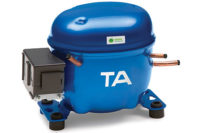That was demonstrated with a number of papers presented at the International Refrigeration Conference here at Purdue University.
DuPont Fluoroproducts noted that “HFC compounds generally have lower global warming potential [GWP] value than CFCs.” It noted that “These values are higher than for fluids such as ammonia, hydrocarbons, and carbon dioxide.”
However, the report went on to say, “To minimize the impact of HFCs on climate change, it is important for the industry to continue improving stewardship-in-use practices.” These include “cradle-to-grave management of emissions, equipment designed and operated for reduced HFC emissions, and improved energy efficiency for reduced carbon dioxide emissions.”
In light of scattergun assaults on HFCs from several European governments, agencies, and environmental groups, the DuPont report noted that the high-profile Kyoto Protocol concerning global warming “is based on a ‘basket of gases’ [of which HFCs is only one component], so no single class of gases must be targeted for phaseout.”
The report did say that, “HFCs are prime candidates for reducing net emissions within the basket of gases. At equivalent costs of other options, climate change impact from minimal refrigerant emissions can be more than offset by improved energy efficiency while meeting reliability and safety requirements.”
Reduced Emissions
The report then went on to catalog how the industry has responded over the years to making energy efficiency improvements and reducing refrigerant emissions.For example, it was noted that energy efficiency ratings of unitary air conditioning in the United States improved from 7 to 10.8 SEER from 1975 to 1995, resulting in a 35% reduction in energy consumption. Data for high-efficiency chillers showed a 33% reduction in energy consumption from 1978 to 1998.
The report also explored progress made in reducing refrigerant leakage, especially in the supermarket sector, long a source of high leak rates. It reported refrigerant loss reductions of 50% to 80% vs. previous operations of traditional supermarkets. DuPont noted moves to distributed systems within stores, as well as the use of secondary-loop systems, as further ways to reduce reliance on refrigerants.
Economizer System
Also reporting on better use of refrigerants was Mobile Climate Control Inc., of North York, ON, Canada, which wanted to know what would happen with economizer technology.The company set up a system with a closed-loop rotary vane compressor, a condenser unit, the high-pressure side of an economizing heat exchanger, an expansion device, and an evaporator unit. The economizer circuit connected the liquid line after the condenser unit with an economizer port of the compressor. This section comprised an additional expansion device, the low-pressure side of the economizing heat exchanger, and the economizer port itself.
Among the company’s findings:
Efficiency Maximized
Scientists at the Solar Energy Laboratory of the University of Wisconsin focused the load-sharing strategies in a multiple compressor refrigeration system. The goal was to “identify operating strategies that properly account for compressor unloading characteristics and maximize the efficiency of the entire system.”Research was done on an ammonia-based industrial vapor compression system serving a two-temperature level food storage facility near Milwaukee, WI.
The project report pointed out that “Part-load compressor operation is required in order to balance the refrigeration capacity of the compressors with the refrigeration demand from the system.”
It further said that “Recipro-cating compressors have near-linear unloading curves and therefore introduce relatively small performance penalties when operated with a low part-load ratios.”
However, screw compressors “require more power per unit in cooling capacity” when unloaded.
Powell is refrigeration editor for The News. You may reach him at 847-622-7260; 847-622-7266 (fax); or PowellBNP@aol.com (e-mail).
Publication date: 09/04/2000


